|
Tags: craft | culture | jade
According to Shuo wen jie zi (The Origin of Chinese Characters《說文解字》): ”Jades are the beauty among all stones.” The connotations evolved from jades, in terms of personal traits, culture, art and moral conduct have mingled together ever since. Each dynasty saw various development of craftsmanship, diverse creations of implements and utilitarian functions, and different roles that jade played. The affection that the Chinese have for these hand-crafted objects of jade has largely enriched the content of the Chinese culture.
With its exquisite craving craftsmanship, its warm luster, and its delicate colors, ancient Chinese jade reaches an exalted position among all antiques. Jade has almost synchronously existed in the course of Chinese history, while the characteristics of greatness, beauty and eternity are personified with humanistic touch. The most clarified definition of jade among Chinese language texts dates back to Shuo wen jie zi, written by Xu-shen in 1 A.D. The author evaluates jade in terms of “five virtues,” which conforms exhaustively to the principles of humanity. Take a look at some excerpts, it reads approximately as follows: “…it is likely to draw a parallel between the warm luster of jade to sympathy, its endurance to bravery, its sound to wisdom, its texture to righteousness, its pureness in shades to honor. Wu Ta-ch'eng (Ching Dynasty), in the preface of his book Ku yü y'u k'ao(Investigations into Ancients Jades with Illustrations《古玉圖考》), encourages “a gentlemen (chün-tzu) would look to specific qualities of jade as a model of human virtue. Since jade is never a plaything; rules and regulations, as well as worship rituals of the government all lie within it. This is how the appropriateness of personal costume and accessories are to be clarified in accordance with the wearers’ social status. Hereto we detect the extent for the ancient Chinese to adore jade makes them endow it with moral features. The Chinese life and character, history and culture are reflected extensively in its usage as well.
While we know jade is the beauty among all stones by the statement provided in Shuo wen jie zi, there are dozens of beautiful stones that have similar but inferior qualities to jade. The most common types of jade utilized in China include Hetian (jade originated in Xinjiang), bowenite, Lantien, plagioclase and cinozoisite (獨山玉). In a broader sense, local materials including crystal, agate, turquoise, malachite, glass, pyrophylite, etc are categorized into beautiful stones through their similarity with jade likewise. It explains the Chinese always have a special attachment for jade. Mineralogically speaking, jade is divided into nephrite (soft jade) and jadeite (hard jade). The former is a variety of the calcium and magnesium rich amphibole mineral actinolite, Ca2(Mg,Fe)5Si8O22(OH)2 with its appearance bears a wax-like gloss of congealed fat. What is called by ancient Chinese as suet jade (white jade), yellow jade, green jade, dark green jade, black jade belong to this categorization. The later is a pyroxene mineral with with composition NaAlSi2O6. It is more familiarly known as emerald. Jadeite features a higher Mohs-scaled hardness and greater density with glass-like luster and better transparency than nephrite.
The discover and usage of bronze and iron reaches its sophistication throughout the successive rules of Hsia, Shang, and Chou dynasties, which meanwhile affects the vertical development of jade. Unlike the circumstance in the primitive society, the usage of jade has expanded from the exclusiveness of nobles to the functions of body decoration, sacrifice offering, ritual worshipping and of being buried along with the deceased. According to the archeological findings of the Shang dynasty from the burial site of Fu-hao, seven categories of jade are distinguished in terms of implements of rites, wands, tools, utensils, ornaments, artistic objects and miscellaneous pedants. To the date of the Han dynasty, functions of jade have reached its comprehension as appliances, accessories, objects for appreciation, amulets, implements of rites and mortuary objects. Implements of rites see their cease of usage after the Han dynasty, which indicates the fact that jade has substantially turned into ornaments and decorative objects. There is no turning back especially when the current moves on to the date of Ming and Ch'ing dynasty.
The tradition of personifying jade as morality and the expansion of territory of central plain in China cause more demand of jade stone, thus extensive popularity of jade takes shape. It has been over eight thousand years that our ancestors assigned a particular image to jade and to set it in a whole framework of society. The atmosphere centers around the ideology carried through the comprehensively humanistic meaning of jade, as well as the progress of the craving skill and tools further improved the depth of the Chinese culture.
NationalMuseum of History
The Digital Preservation Project of Historical Interest
|
Pi disk
Diameter:15.8cm/Diameter of perforation: 4.4cm
In ancient China, heaven is thought to be round while the earth square. The ancestors worship the gods with their observation of natural phenomena, and round-shape pi (doughnut shape flat jade)was thus created to facilitate the rites. The pi also represents wealth and power. Though this item is plain, groundwater and mineral substance infiltrated inside result in a multi-colored appearance. Considered to be a remarkable work during the antiquity, its simplicity adds a mysterious touch.
|
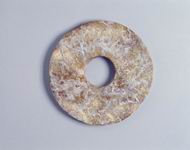 |
|
Ts'ung ritual tube
Diameter: 5.9cm/Diameter of perforation: 4.8cm/Thickness: 0.5cm
Similar to an armlet, the item is higher than that. Legend has it that the shape of “Ts'ung” originated from a smokestack. Affected by the concept of five elements (metal , wood , water , fire , and earth) with the course of time, it has evolved into a square shape in the outer side and round in the inner. This item is a white jade and suffused with purplish-brown. It covers with warm luster and the translucent texture and supposed to be categorized into its earlier pattern of Ts'ung.
|
 |
Kylin-shaped tally
16.5cm/Width: 4.9cm
The model of Kylin-shaped tally is initially documented since the time of the Sui dynasty. The item functions as tokens that were used during war time. The item, featuring the shape of a knife, categorized to white jade. The sophisticated skill of carving and its translucent texture make it the best quality among others.
|
 |
Zhì, scabbard buckle
12.5cm/Width: 2.8cm
Zhì is decorated in the middle of a scabbard and is noted as a nose-like shape. A leather belt is to be worn through the hole of it to be fastened on one's body. Cloud motifs in paired lines are craved on the surface of this item. It categorized to white jade and suffused with brown color by iron permeation.
|
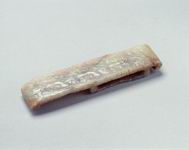 |
|
Chuàn, armlet with tiger face decor
Thickness: 0.6cm/Outer diameter:7.3cm/Diameter of perforation: 6cm
An item with a circular shape and smooth texture in the inner side. Exquisite craving on the outer side shows glutton motifs. Chuàn is an armband worn by both males and females on the upper arm during the antiquity. However, it was reserved for wearing of females. The item categorized to green jade and suffused with grayish-brown. Rare ornaments feature both simplicity and sophistication such as this one.
|
 |
|
Pi Xiu, white jade, suffused with mercury
Length: 6.2cm/Width: 3cm/Thickness: 1.5cm
The item is greenish-white jade and suffused with black and brown colors. Pi Xiu is seen most frequently during the Western Han period but at that time, it was usually made of bronze material. The model used to be put in the hall to produce an impressive sight. The same type model crafted in jade has not seen its appearance until the Eastern Han period. A smaller ornamental version, as well as a decorative version on gravesites turn up by a newly-applied suggestion of protection from and banishment of evil.
|
 |
Pi disk with okra permeation
Diameter:15cm/Diameter of perforation: 5.2cm
Pi disks are perforated in the middle. The yellowish appearance is seemed as okra color. The area in black is the result of permeation of manganese. Cloud patterns are craved into eight circumscriptions. Although appeared as a model belonging to the antiquity, the item is de facto an imitation crafted in the Sung dynasty.
|
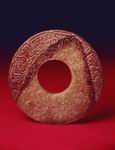 |
|
Jadeite archer's ring
Length: 2.6cm/Diameter:3.2cm/Diameter of perforation: 2cm
Archer's rings are categorized as a kind of males’ accessory. It is a sheath worn by archers on thumbs, originally made of leather. Then appears jade imitations which have evolved into a ring shape. After the middle of the Ch'ing dynasty, it is worn by males who are in higher social status. They hold the cuffs by wearing this kind of ring on thumbs. The trend has not vanished until in the republic of China. The texture has highest quality among jadeite with greenish color all over its body and transparency. Relatively large in volume, the item is a rare treasure.
|
 |
|
All-greenish jadeite belt-hook
Length: 10cm/Width: 3.5cm
This item is originally crafted from one single jade stone. An emerald green color is suffused all over, intermingling with some white. Its texture and craftsmanship ranks high among imperial use. Jadeite is noted for its hardness, which is about 6.5 to 7 in the Mohs scale. Craving in openwork is applied with motifs of a pair of hornless dragons. Featuring vivid imitation of dragons’ flying and holing a glossy in the mouth, it is abundant with vitality. The polishing work of the item is also worth mentioning, for the fine texture is utterly presented through it. This item might as well to be one of the best examples that provides an open door to investigation of antiques during the Ch'ing dynasty.
|
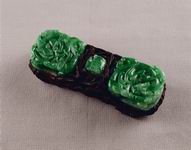 |
|
White jade paired fish decor
Length: 4.4cm/Width: 7.8cm/Thickness: 1cm
The item categorized as white jade. Fish motifs are craved in openwork to symbolize affluence. A moveable design of chain is originally crafted from one single jade stone. Such craftsmanship features incredibly difficult skills.
|
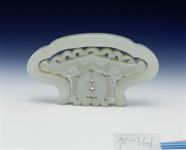 |
|
Lóng, green jade pedant with paired dragon decor
Diameter: 6cm
Lóng is homophonous in Chinese language with a dragon. It is an implement of rites specially used while praying for rain. Afterwards a smaller version of ornament appears. The item is circular with two dragons incised on the outer side. Inside the perforated hole a dragon is also craved. Permeated with red dots and in beeswax color, the item arouses an antique ambience.
|
 |
|
Huang, pendant with paired dragon decor
Length: 1.5cm/Width: 8.6cm/Thickness: 0.3cm
The item is a jade pendant in a semi-circular shape. Two dragons overlap their bodies and tails in the middle, both heads directing each side. Cloud patterns are incised with light cameo with hidden lines. The design of the shape fully presents the creativity of its craftsman. Featuring in beeswax color, the warm luster and translucent texture make the item a rare treasure.
|
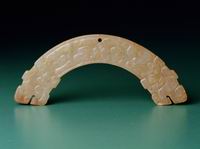 |
|
Jué, penannular jade ring
Thickness: 0.2cm/Diameter: 4cm/Diameter of perforation: 1cm
Featuring in greenish-white color, the item was broke into two pieces while being excavated. Then it is reconstructed into a circular shape with a breach at one side. The original texture is slightly appeared. Without any patterns craved on the surface, lignification, red dots and blackish permeation are shown. The verge of the breach appears a shape of a slope, wider in the outer side and narrower in the inner. The thickness of the penannular ring turns out to be asymmetrical.
|
 |
|
Pendant with dragon decor
Length: 4.8cm/Width: 7.6cm/Thickness: 0.4cm/Diameter of perforation: 2.6cm
It is a green jade with translucence and warm luster. A loop is designed to reach beyond the outline of the whole body with hornless dragons motif winding with each other at the second and third layers. A three-dimensional effect is created through craving in openwork. With dragons’ round eyes, noses rolling up and tongues sticking, the lines of its contours are craved with fines of intaglio. A freely flowing style of craving, as well as some red dots and soil permeated within can be observed. Both of the front and back sides of this item feature the same motifs.
|
 |
|
Jade swallow
Length: 2.5cm/Width: 1.8cm/Thickness: 0.5cm
It is a greenish-white jade and slightly suffused with red dots. The item is crafted as a swallow spreading its wings with a round head and protruding eyes. The frontage is incised with light cameo with reduction of canvas. Its tail imitates that of fish. A two-sided hole in perforated in the middle from mouth to tail, which evidences a typical model in the works of the Shang dynasty. While the item is excavated in a gravesite belonging to an emperor of the Chou dynasty, it is very much likely to be looted from the Shang dynasty and is granted to one of the principalities by the royal family of Chou.
|
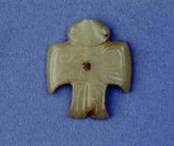 |
|
Jué, penannular jade ring
Depth: 0.6cm/Thickness: 0.6cm/Diameter of perforation: 1.5cm/Outer diameter: 2.7cm
The item belongs to greenish-yellow jade and suffused with blackish-brown color. Its original texture can be observed in some areas of the canvas. With a cylinder shape, one breach is craved at one side, which is wide on the outer side and narrow in the inner side. A hole is perforated in the middle with a metal tool. Smooth texture is featured on the surface in the inner side. Cameo of snake and dragon motifs can be observed all around the body of this item. With its mouth open, nose rolling up and round eyes, as well as extremely fine lines of intaglio as feathers decorated at the lower part of its nose, snake and cloud patterns are craved into five circumscriptions. A model of a pair of this kind is rarely seen. The permeation of red dots occurs after its burial. It was excavated in Xinzheng county and should date back to late Ch'un-ch'iu period.
|
 |
|
Héng, top gem of a girdle-pendant
Length: 9.3cm/Width: 2.9cm/Thickness: 0.4cm
It is originally a white jade and later suffused with yellowish-brown color. Some red dots and soil permeated within can be observed. The type of this item belongs to the Héng category. A series of edges and corners are carved on the margin. Two dragons overlap their bodies and tails in the middle, both heads directing each side. Motifs of clouds and snakes are shown on the surface. Feather intaglio patterns are incised among clouds. Both of the front and back sides of this item feature the same motifs. The original model is selected from an ensemble of jade which type and motif were popular during the Eastern Chou period.
|
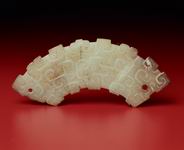 |
|
White jade of Ruyi
Length: 40.8cm/Width: 6.9cm/Thickness: 2.5cm/weight: 348g
The item is one piece of a pair featuring smooth texture, translucence and a gloss of congealed fat. A hornless dragon is incised in the head, while bats holding two fishes are seen in the middle with the connotation of prosperity and good luck. A chain of rings at the end is carved from the same material, which witnesses an astonishingly skilled craftsmanship.
|
 |
|
Ruyi of red-and-white agate
Length: 45.7cm/Width: 9.7cm/Thickness: 5cm/weight: 629.2g
The item is one piece of a pair. Two persimmons are incised in the head by taking advantage of its original agate bright red color with suggestion of best wishes. In the middle there is a bundle wrapping the stem, while day lilies are carved in the end. The contrast of red flowers and the white stem provides a joyous sight.
|
 |
|
Cloud-shaped Ruyi
Length: 39.4cm/Width: 7.3cm/Thickness: 3.6cm/weight: 551.5g
From one chunk of dark green jade, a pair of ruyi are carved. This tem is incised “long life” in seal characters on the head, motifs of lotus and ribbon in the middle, and two twisted persimmons and lotus in the end with the implication of best wishes, happiness and longevity.
|
 |
|































